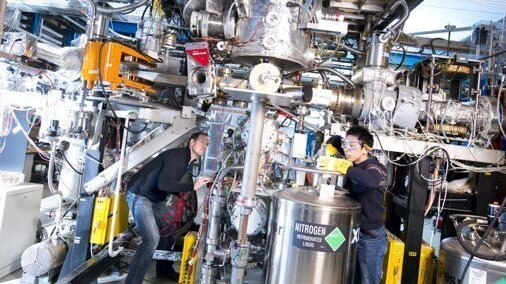
- Light
Published: | By: Stephan Laudien
Source article
An international research team has successfully conducted ultra-precise X-ray spectroscopic measurements of helium-like uranium. The team, which includes researchers from Friedrich Schiller University Jena and the Helmholtz Institute Jena, has published results demonstrating their success in disentangling and separately testing one-electron two-loop and two-electron quantum electrodynamic effects for extremely strong Coulomb fields of the heaviest nuclei for the first time. The researchers have now published their results in the specialist journal “Nature”.
Millions of passes per second in the linear accelerator
The published paper detailed basic research into the age-old question of what holds our world together at the innermost level. Dr Robert Lötzsch, an experimental physicist at the Institute of Optics and Quantum Electronics at the University of Jena, says that the special part of this project is that measurements were conducted on the heaviest stable atoms. “When measuring a hydrogen atom, which has the atomic number one, we can precisely measure the electron transitions to 13 decimal places,” says Dr Lötzsch. He explains that for uranium, which has the atomic number 92, precise measurements have been taken to five decimal places. The measurement focuses on the transition between different orbits. The experiments took place at the GSI/FAIR experimental storage ring in Darmstadt—a particle accelerator complex used by several European countries. Study groups from Poland, France, Portugal and Germany were involved in the recent measurements under the leadership of Martino Trassinelli and Robert Lötzsch. The Darmstadt complex comprises an ion storage ring with a circumference of over 100 metres and an upstream accelerator that extends for over a kilometre.
Robert Lötzsch describes the experiment as follows: firstly, free ions are produced. In order to achieve this, uranium is vaporized and then vastly accelerated to around 40 % of the speed of light. The resulting material is then fed through a special film, losing electrons in the process. The accelerated electrons are guided then into a storage ring, where they race around a circular path. “The particles flash by our spectrometers up to 50 million times per second and, occasionally, there is an electron transition we can measure using a spectrometer,” says Lötzsch. The special Bragg crystal spectrometer used in the experiment was constructed in Jena.
The specifically bent crystal developed in Jena
The linchpin in the spectrometer, Robert Lötzsch explains, is a specifically bent crystal made from the element germanium. “This crystal is as thin as a sheet of paper and is held in a special glass mould,” says Lötzsch. This technique requires considerable expertise and was developed in Jena. Research into the development of such measurement devices has been underway for over 30 years.
The results published by the research group are the outcome of an experiment conducted in 2021. The tests ran for three weeks over Easter in conditions complicated by the COVID-19 pandemic. Nevertheless, Lötzsch believes the results are well worth the effort: “We have successfully tested whether our theoretical understanding also applies to this exotic niche of materials.” The results, he says, will therefore help to further our understanding of what “holds the world together at the innermost levels”.
Original publication:
Robert Loetzsch et al.: „Testing quantum electrodynamics in extreme fields using helium-like uranium“, Nature 625, https://doi.org/10.1038/s41586-023-06910-yExternal link